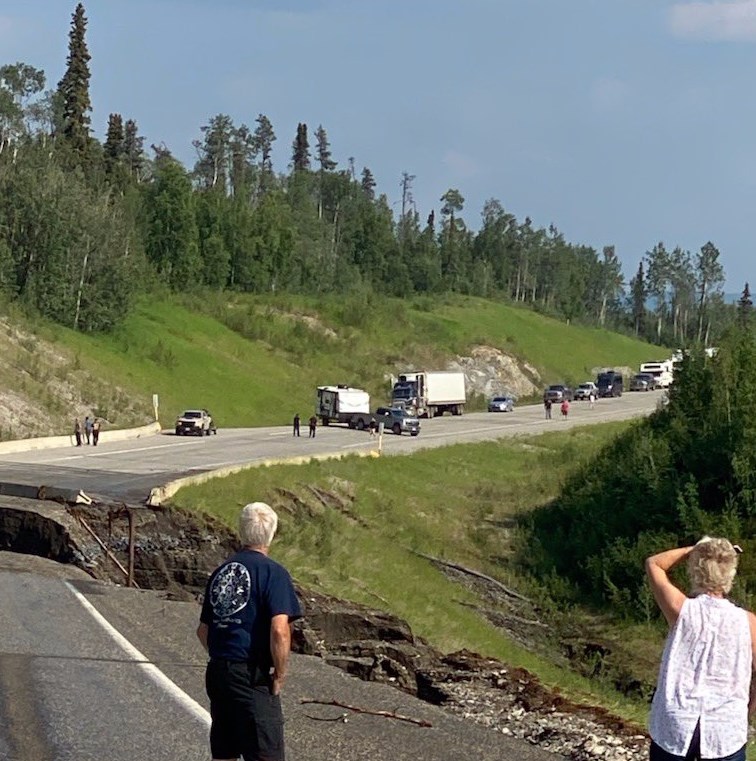Update, 2:55 p.m.:
Public Services and Procurement Canada has issued the following statement:
"Public Services and Procurement Canada (PSPC) was made aware that a section of the Alaska Highway near KM 897 was washed out on July 1, 2022. The heavy rainfall that had occurred over the preceding weeks in the area resulted in the collapse of a beaver dam. The resulting runoff event carried stones and loose debris which blocked the existing culverts under the highway. With the blocked culvert flow, the runoff then backed up, eventually to the point where it overflowed across the road surface. The flow was so high that it completely washed out a 75m stretch of the highway.
"PSPC notified the Highway Maintenance contractor who arrived on-site on July 1st. Traffic barriers were put in place and work was started to get a detour in place as soon as possible. The work on the detour was completed on July 4th at 3p.m. PST. The detour is single-lane only. Traffic control is being maintained with a pilot car. The detour will remain in place until the work to repair the main section of highway is completed. The issue was reported in the PSPC daily road report on July 2nd which is issued to local stakeholders including, BC and Yukon media outlets, tourism offices, motels, RCMP, Ministry of Transport and Infrastructure Drive BC, and local radio stations, etc.
"The engineered repairs required for the main section of highway will take 6 to 8 weeks to complete. All efforts will be expended to ensure the repairs are completed as soon as possible. With an average of 800-1,200 daily travellers on the Alaska Highway, PSPC will ensure that the public is aware of closures and the impacts on local traffic through public notices that will be issued in advance and shared through our social media channels. The same information will be distributed to stakeholders for further broadcasting. In the meantime, people travelling are advised to obey traffic signs and follow the pilot car on the assigned detour route."
Original story:
Engineers are on their way to a major washout along a remote section of the Alaska Highway in Northern B.C. to assess damages and determine a fix, officials say.
The washout destroyed a massive section of paved highway about 125 kilometres north of Liard Hot Springs on July 1, snarling long weekend traffic travelling in both directions, and prompting some stores in the Yukon to ration goods.
George Smith, manager of maintenance for the portion of the Alaska Highway under federal jurisdiction, says engineers flew into Fort St. John and are driving north today. They’ll be flown to the site tomorrow to assess what happened and what the options are to restore the road.
“The pictures don’t do it justice,” Smith said Tuesday of the scale of damage.
It’s believed the washout was caused by a beaver dam collapse, which brought with it a torrent of water backed up from a nearby lake.
On Canada Day, the traffic monitoring service DriveBC had reported water pooling between the Fireside Maintenance Camp and Allen’s Lookout. Just hours later, however, the road gave way, destroying a large section of paved highway.
“The beaver dam let go, the lake more or less drained, and took the highway out,” Smith said.
Traffic on the both sides of the large crevasse have been kept back due to the instability of the nearby hillside and the potential for more erosion.
A three-kilometre detour has since been opened using an old alignment of the highway. Smith says crews had to put in a culvert, fix approaches to the highway, and “do some dirt work” before it could be opened.
He says the detour is being maintained and monitored daily with the help of Lower Post First Nation, and open 24 hours to single-lane alternating traffic with a pilot car.
The “road is good” and there are “no restrictions as of yet,” Smith said, noting transport trucks and motor homes are being piloted through. He asked motorists to be patient and obey the signs.
“It’s taken the pilot car nine to 10 minutes to get traffic through there,” he said. “We can’t stress enough that they obey signs and wait for the pilot car.”
Have a story or opinion to share? Email your letters to editor@ahnfsj.ca



